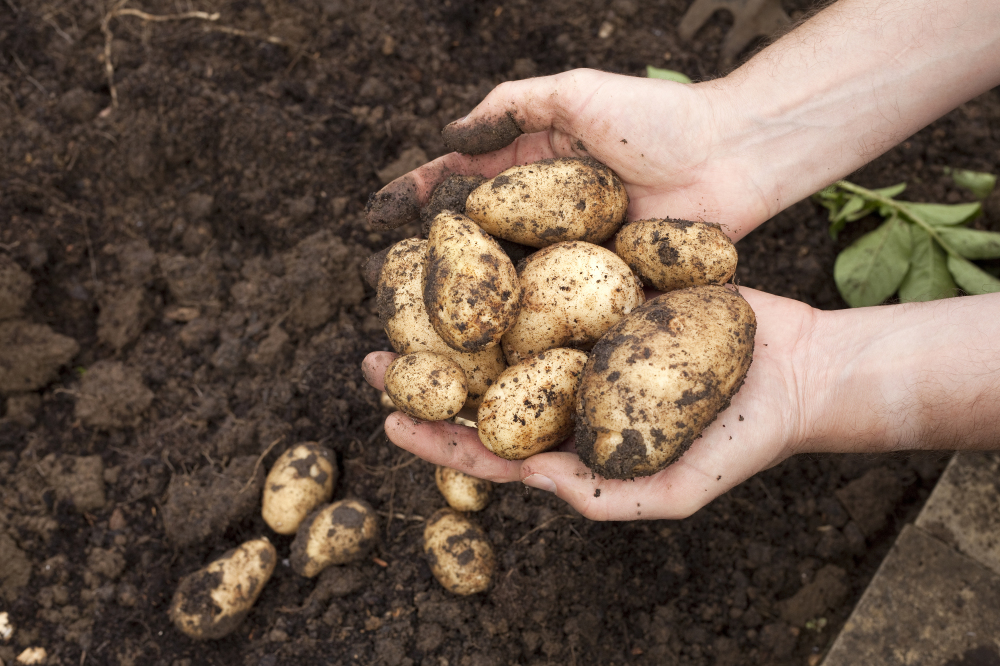There's nothing more satisfying than growing your own spuds in the garden and enjoying their fresh flavour in a Sunday roast.

How do you grow your own potatoes?
Whether you take them mashed, boiled, roasted or baked, these hardy root vegetables are fairly easy to grow for the beginner gardener and you don't need loads of space to plant them either.

With more of us tending to our gardens while observing social distancing rules, it's the perfect time to give this green project a go. In fact, research by LoveTheGarden has found that more people have been searching for potato growing tips since lockdown began.
"Now is a great time to grow small, new potatoes of the Estima, Wilja or Kestra varieties, which will be ready just ten weeks after planting," says Elaine Gotts, a gardening expert at Evergreen Garden Care.
"Potatoes are easy to grow in bags, containers or in the ground and will be absolutely delicious for your late-summer picnics and barbeques."
If you're lucky enough to have space in your garden to harvest potatoes, we've put together a step-by-step guide for getting your grow on this summer.
Step 1
They're grown from 'seed potatoes', which are small potato tubers, rather than actual seeds.
"If you're purchasing seed potatoes that are ready to plant from the garden centre, you are ready to get started," says Gotts.
"If not, you can 'chit' them (encouraging the seed potatoes to sprout before planting) yourself at home by placing them in egg boxes or a seed tray with the blunt 'end' upwards."
Each seed potato has a rounded, blunt end with a number of 'eyes' which should be facing up to the sky.
"Keep the seedlings in a cool place with good light. This will help to grow the sturdy green shoots needed to increase your crop bounty."
Step 2
Creating the right soil environment can really take your spuds to the next level.
"Potatoes grow in almost any soil, but for optimum results add well rotted manure and garden compost to your pot, bag or the ground where you're planning to grow them," advises Gotts.
Step 3
When it comes to planting, all you'll need us a good pair of gardening gloves, a trowel and a watering can.
"Plant the potatoes 10-12cm deep in the soil with the shoots facing upwards. Once planted into the ground, bed them in more compost so that the potatoes are well covered," says Gotts.
"Keep the composts well watered so that soil is moist, making sure not to saturate them, as this will cause rotting."
Step 4
When the green shoots are around 20-30cm tall, Gotts recommends adding some extra soil around the stems to exclude any light from potatoes that are growing closer to the surface.
"A liquid plant food such as Miracle-Gro Performance Organics Fruit & Veg Liquid Concentrate Food will help your potatoes grow even bigger," she adds.
Step 5
"After 10 weeks, your potatoes will be ready to harvest," says Gotts. The foliage on the plants should have withered and died at this point too, which is a sign that they're ready to be dug up with a trowel.
"Make sure that you reject any green potatoes as these can be poisonous," she warns.
A final word on protecting your spuds
Blight is a common disease that can affect potatoes and can ruin your whole crop if you're unlucky. In fact, it was thought to be the cause of the widespread potato famine in Ireland in 1845.
To prevent blight, it's a good idea to plant your potatoes in a spot that allows for good airflow and plenty of space away from other plants.
Rotate the area where you grow your potatoes between each harvest to prevent build up of the disease in the soil, and remove any infected plants as soon as you spot the telltale signs of blight – dark brown blotches on shrivelled leaves – before it has a chance to spread.

